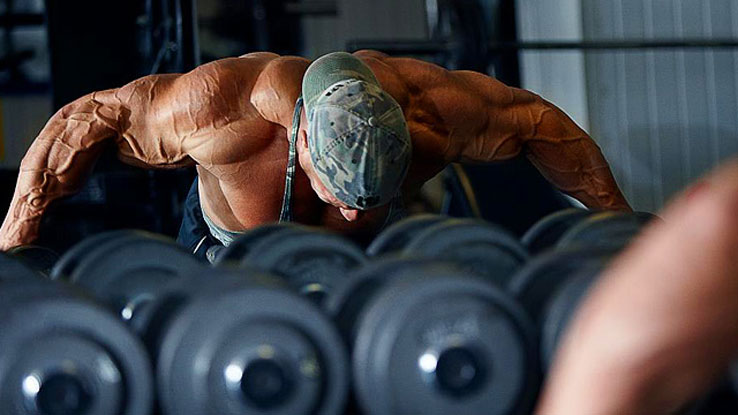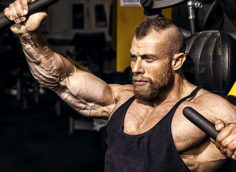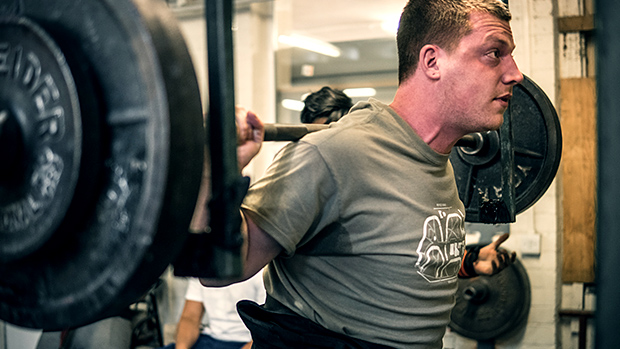Here's what you need to know...
- No matter what the goal, you simply can't go wrong by making strength a priority.
- Check your ego. Allow yourself to be coached by someone more knowledgeable.
- Numbers don't lie. If you're getting stronger, you're getting better.
- Stop working hard for the sake of working hard. Practice training economy and maximize the results of your efforts.
Over my 30-year career in the fitness biz, I've experimented with a lot of things that seemed promising at first, only to end up on the scrap heap in the end. But seven concepts have remained tried and true over the past three decades. As a bonus, I'll also share three ideas that I'm taking a second look at.
1 – The Fundamental Importance of Strength
The ironic thing about strength is this: It's the most important thing, but it's also the hardest thing to "sell." Strength doesn't require fancy tools or strategies. In fact, some of the strongest men who ever lived became that way by lifting with crappy equipment, using ill-advised training strategies, and eating shitty food.
In other words, it's something you can achieve autonomously no matter what your situation – if you're willing to work for it. This first point is far and away the most significant item on this list. You simply can't go wrong by prioritizing strength development, no matter what your goals are.
Examples of this are everywhere: 2013 Crossfit Games winner Rich Froning can snatch 300 pounds. Golfing great Gary Player squatted over 300 pounds (at a bodyweight of 150). The point is, no matter what your athletic goals, getting stronger will create a faster path to them.
Hypertrophy? Hypertrophy is really a secondary adaptation to strength development. In other words, while it's technically possible to develop hypertrophy without focusing on maximum strength, you nevertheless need to enforce continuous progressive overload if you expect to see continued gains in muscle mass.
Endurance? As Fred "Dr. Squat" Hatfield loved to point out, even in the marathon, all else being equal, the winner is the athlete who can (footfall per footfall) apply the most force into the ground over the course of 26.2 miles.
Injury prevention? Pavel Tsatsouline reminds us that muscle tension (created by being strong) is one of the most important things you can do to ensure joint integrity. And flexibility? Flexibility expert Tom Kurz argues that poor adductor strength is the main thing that prevents martial artists from attaining full splits.
While these examples are intuitively obvious, it's amazing to see how many people are gradually lured away by the nearly endless array of "cutting edge" fitness strategies and tools that, although intriguing, don't do anything to directly improve your strength. If you're considering something that doesn't directly or at least indirectly lead to strength gains, re-think the decision.
2 – Getting Coached
When you work in the strength and conditioning biz like I do, there are at least two reasons why you tend to coach yourself. First, you want everyone to think you're an expert, and if you're an expert, you don't need a coach. Makes sense, right? Also, whoever is coaching you, by definition, must know more than you do, and you fear that this will reduce your own expert status in the eye of your peers and/or fans.
The second reason expert-types tend to coach themselves is that they think they know more than anyone else. This is partly a matter of ego-stroking, but it also has at least a kernel of logic behind it – who knows you better than you?
Some time ago I decided to split myself into two distinct personalities when it comes to this issue: I created Charles Staley the expert, and Charles Staley the student. I always embodied both facets of my personality, but I finally decided to let the student part of me out of the closet. This freedom allowed me to comfortably and enthusiastically seek coaching from my colleagues who not only know as much or more than me on a number of subjects, they also had more objectivity about my needs than I did.
The result? Continued progress, at a faster pace, and with greater efficiency. I should point out that coaching doesn't always need to take the traditional form of personal training that you're probably envisioning. It can also mean a smart training partner, conversations with other athletes or coaches, or video form checks with a trusted (but distant) colleague.
Finally, if you decide to seek out free advice from a well-known authority, let me give you a tip. Don't simply write them on Facebook and ask, "Dude, would you check out my squat form? I know the video is kinda dark, but you should be able to make it out."
A better approach would be something like, "Hi there, I hope you won't mind the intrusion, but I just bought your e-book, and I've admired your work for a long time. I wondered if you might be willing to tell me if my low back looks okay on these squats? I'd be very appreciative!"
Catch my drift here? Demonstrate gratitude, be polite, and ask for something quick and specific.
3 – Back-Off Sets
There are two different strategies you can use for programming strength and hypertrophy simultaneously. You can either schedule a hypertrophy day and a strength day (every week or microcycle), or you can train both qualities every session through the use of back-off sets.
While both strategies are effective, it's a waste to not take advantage of the neural facilitation created by a heavy top set. When preceded by a heavy (but not necessarily maximal) set of 1-3 reps, you'll have a superior performance with a lighter (5-10 rep) back-off set than you would've had otherwise. This means more reps than you could normally perform, which translates into better gains.
Another advantage is that if your top set ends up being a disappointment, you still have the chance to redeem yourself with the back-off set. One of Bret Contreras' favored strategies is to keep track of your 1, 3 and 5 rep PR's for your most important lifts. On any given workout, attempt to break one or more of these rep records. Often, on a day when a new 1RM is out of reach, you still stand a solid chance of breaking your 3 or 5RM record.
4 – Performance Over Pain: Know Your Numbers
You can't improve performance without some type of change in the structure that accomplishes the performance.
Now it's true that maximal strength can improve through changes in neural adaptation alone. However, the longer you've been training, the more your strength improvements come from increases in muscle cross-section rather than improvements in your nervous system.
Numbers don't lie. After all, it's possible to have a workout where you got a wicked pump, puked with the intensity of your effort, and had a case of severe DOMS that lasted for days, yet didn't get any stronger.
But if you simply get stronger (i.e. your numbers improved), you also just improved your body. There's really no way around it. Know your current 5RM, 3RM, and 1RM records for significant lifts and always be on the lookout for an opportunity to break them.

5 – Training Economy
I sometimes find myself taken in by high-volume and/or high-frequency approaches to training, such as the Bulgarian system. And while I'll certainly argue for the value of hard work, I'll argue even harder that ideally, you should strive for maximum results with a minimal expenditure of resources.
Think about your training the same way you'd think about running a business. Would you rather make $1000 with $300 worth of expenses, or make $1000 with $200 worth of expenses?
Look, being economical isn't the same thing as being lazy – far from it. It doesn't mean that you're trying to get something for nothing, nor does it mean that you're trying to cut corners. It simply means you're looking to absolutely maximize the results of your efforts. I urge you to let go of your ego and stop working hard for the sake of working hard. Get your results from the least amount of work possible, and then dedicate any remaining energy you have to other areas of your life.
6 – Process Orientation
Outcomes are much more difficult to control and predict than the process that leads to the outcome. Why? Probably because outcomes are the result of both internal and external factors. You can control the internal factors (the work and dedication you supply), but not necessarily the external factors (injury, illness, social obligations, economic difficulties, and so on).
With that being the case, it makes sense to focus on what you can control, and ignore everything else. To me, "process orientation" involves attaining a high level of knowledge, and your willingness to apply that knowledge in the pursuit of excellence. It means focusing on doing the right things, consistently, and letting the chips fall where they may. Then, if your outcome is disappointing, it means that your process was faulty and in need of revision.
7 – Hard Work Reduces Your Margin Of Error
In training circles, you'll hear a lot of discussions where people debate the relative importance of working hard versus working smart. Both are important, but if I had to pick one I'd go with working harder.
I've seen many highly successful athletes who made very fundamental, significant mistakes in their training, but succeeded nevertheless. While an argument could be mounted that these athletes would've done even better had they made wiser choices, I still believe that work ethic is what most wannabes are lacking.
3 Things I'm Just Warming Up To
1 – Machines/Isolation Exercises
I've been shortsighted throughout most of my career regarding this particular issue, and I'm not proud of it. For example, whenever I'd see someone performing leg presses or triceps pushdowns, I'd roll my eyes in disdain.
My rationale, incidentally, was that machine and isolation movements don't carry over into "real world" activities. Also, I'd assume these people had purely cosmetic reasons for lifting, which I deemed superficial. In other words, I'd become a snob. Meanwhile, my own physique had no aesthetic appeal whatsoever, so I guess I paid the price for my ignorance.
Now, don't get me wrong. Free weights are still a better alternative in the majority of cases, but it's not an all-or-nothing proposition, is it? There are good and bad programs, but for the most part, there really are no "bad" exercises. Everything depends on context.
So, yes, there are definitely situations where machines and/or isolation exercises have a very definite place in the overall process. In my own case, I find it very difficult to train my quads due to long levers. On any type of squatting or pulling movement, it's all hamstrings and adductors.
After a few discussions on this subject with my training partner, Bret Contreras, I decided to add a few sets of leg extensions to my lower body sessions. These sets only require about 15 minutes twice a week and they create a focused tension on my lower quads that no other exercise can match.
As a tall, long-levered raw powerlifter, my quads are definitely the weakest muscle group in my squat, and it shows in my physique as well. The jury's still out, but I'm very confident that this small amount of isolation work for my quads will pay off.
2 – Aesthetic Goals
There's nothing wrong with looking like you lift, is there? I admit to having had a blatant disregard for aesthetics through most of my career, and it was a big mistake. Honestly, if you don't look like you lift, is it possible that maybe something's wrong with your program? After all, do you know of any significantly strong people who don't look like they lift?
If you're a coach or a trainer, it's impossible to overestimate the importance of looking the part, both in terms of attracting new clients and also in terms of inspiring the trust of your current ones.
3 – Tall Lifters Need To Pay Attention To Distal Body Parts
In my pursuit of posting better numbers in raw powerlifting, it became painfully clear that my quads were far and away the weakest link in my squat. Not surprising, after all, given that I'm over 6 feet tall with disproportionately long femurs. This led me to consider including more direct quad training.
Along similar lines, I recently ran across a video of Mark Bell talking about how big biceps can serve as a "shock absorber" in the eccentric portion of the bench press. In other words, on the descent, bigger biceps will compress against the forearms, much as the hamstrings compress into the calves on the squat. Now this hasn't encouraged me to try making a career of quad and arm training – we're talking just 2-3 sets per session, but with high intensity and with an eye toward progression.
Training doesn't need to be an either/or proposition. A few sets here and there are often enough to see a difference.





